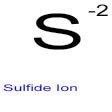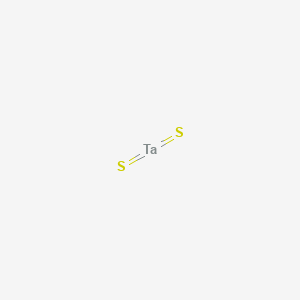SECTION 1. IDENTIFICATION
Product Name: Tantalum Sulfide
Product Number: All applicable American Elements product codes, e.g. TA-S-02
, TA-S-03
, TA-S-04
, TA-S-05
CAS #: 12143-72-5
Relevant identified uses of the substance: Scientific research and development
Supplier details:
American Elements
10884 Weyburn Ave.
Los Angeles, CA 90024
Tel: +1 310-208-0551
Fax: +1 310-208-0351
Emergency telephone number:
Domestic, North America: +1 800-424-9300
International: +1 703-527-3887
SECTION 2. HAZARDS IDENTIFICATION
Signal Word: Warning
Hazard Statements: H315 Causes skin irritation.
H319 Causes serious eye irritation.
H335: May cause respiratory irritation
Precautionary Statements: P261 Avoid breathing dust/fume/gas/mist/vapors/spray.
P280: Wear protective gloves/protective clothing/eye protection/face protection.
P305+P351+P338 IF IN EYES: Rinse cautiously with water for several minutes. Remove contact lenses, if present and easy to do. Continue rinsing.
P304+P340: IF INHALED: Remove victim to fresh air and keep at rest in a position comfortable for breathing
P405: Store locked up
P501: Dispose of contents/container in accordance with local/regional/national/international regulations.
HMIS Health Ratings (0-4):
Health: 2
Flammability: 1
Physical: 1
SECTION 3. COMPOSITION/INFORMATION ON INGREDIENTS
Chemical Family: Ceramic
Additional Names: Tantalum disulfide
Tantalum sulfide (TaS2):
Percentage: 100 wt%
CAS #: 12143-72-5
EC #: 235-265-3
SECTION 4. FIRST AID MEASURES
General Treatment: Seek medical attention if symptoms persist.
Special Treatment: None
Important Symptoms: None
Inhalation: Remove victim to fresh air. Supply oxygen if breathing is difficult.
Ingestion: Seek Medical Attention.
Skin: Wash affected area with mild soap and water. Remove any contaminated clothing.
Eyes: Flush eyes with water, blinking often for several minutes. Remove contact lenses if present and easy to do. Continue rinsing.
SECTION 5. FIREFIGHTING MEASURES
Flammability: Non-flammable
Extinguishing Media: CO2, extinguishing powder or water spray. Fight larger fires with water
spray or alcohol resistant foam.
Spec. Fire Fighting Procedure: Use full-face, self-contained breathing apparatus with full protective
clothing to prevent contact with skin and eyes. See section 10 for decomposition products.
SECTION 6. ACCIDENTAL RELEASE MEASURES
If Material Is Released/Spilled: Wear appropriate respiratory and protective equipment specified in
special protection information. Isolate spill area and provide ventilation. Vacuum up spill using a high efficiency particulate absolute (HEPA) air filter and place in a closed container for disposal.
Take care not to raise dust.
Environmental Precautions: Isolate runoff to prevent environmental pollution.
SECTION 7. HANDLING AND STORAGE
Handling Conditions: Wash thoroughly after handling.
Storage Conditions: Store in a cool dry place in a tightly sealed container. Store apart from
materials and conditions listed in section 10.
Work/Hygienic Maintenance: Do not use tobacco or food in work area. Wash thoroughly before
eating and smoking. Do not blow dust off clothing or skin with compressed air.
Ventilation: Provide sufficient ventilation to maintain concentration at or below threshold limit.
SECTION 8. EXPOSURE CONTROLS/PERSONAL PROTECTION
Permissible Exposure Limits: N/A
Threshold Limit Value: N/A
Special Equipment: None
Respiratory Protection: Dust Respirator
Protective Gloves: Rubber gloves
Eye Protection: Safety glasses or goggles
Body Protection: Protective work clothing. Wear close-toed shoes and long sleeves/pants.
SECTION 9. PHYSICAL AND CHEMICAL PROPERTIES
Color N/A
Form: Powder, Granules, Pellets, Sputtering target, Custom parts
Odor: Rotten eggs smell
Water Solubility: Insoluble
Boiling Point: N/A
Melting Point: 3000 °C
Flash Point: N/A
Autoignition Temperature: N/A
Density: 6.86 g/cc
Molecular weight: 245.08 g/mol
SECTION 10. STABILITY AND REACTIVITY
Stability: Stable under recommended storage conditions
Reacts With: Acids, Halogens, Alkali metals, Oxidizing agents
Incompatible Conditions: None
Hazardous Decomposition Products: Hydrogen sulfide, Sulfur oxides, Metal oxide fume
SECTION 11. TOXICOLOGICAL INFORMATION
Potential Health Effects:
Eyes: May cause irritation
Skin: May cause irritation
Ingestion: May cause irritation
Inhalation: May cause irritation
Chronic: N/A
Signs & Symptoms: N/A
Aggravated Medical Conditions: N/A
Median Lethal Dose: N/A
Carcinogen: N/A
SECTION 12. ECOLOGICAL INFORMATION
Aquatic Toxicity: Low
Persistent Bioaccumulation Toxicity: No
Very Persistent, Very Bioaccumulative: No
Notes: N/A
SECTION 13. DISPOSAL CONSIDERATIONS
Dispose of in accordance with local, state, national, and international regulations.
SECTION 14. TRANSPORT INFORMATION
Hazardous: Not hazardous for transportation.
Hazard Class: N/A
Packing Group: N/A
UN Number: N/A
Proper Shipping Name: N/A
SECTION 15. REGULATORY INFORMATION
Sec 302 Extremely Hazardous: No
Sec 304 Reportable Quantities: N/A
Sec 313 Toxic Chemicals: No
SECTION 16. OTHER INFORMATION
Safety Data Sheet according to Regulation (EC) No. 1907/2006 (REACH). The above information is believed to be correct but does not purport to be all inclusive and shall be used only as a guide. The information in this document is based on the present state of our knowledge and is applicable to the product with regard to appropriate safety precautions. It does not represent any guarantee of the properties of the product. American Elements shall not be held liable for any damage resulting from handling or from contact with the above product. See reverse side of invoice or packing slip for additional terms and conditions of sale. COPYRIGHT 1997-2022 AMERICAN ELEMENTS. LICENSED GRANTED TO MAKE UNLIMITED PAPER COPIES FOR INTERNAL USE ONLY.

 The number of electrons in each of Sulfur's shells is 2, 8, 6 and its electron configuration is [Ne] 3s2 3p4. In its elemental form, sulfur has a light yellow appearance. The sulfur atom has a covalent radius of 105 pm and a Van der Waals radius of 180 pm. In nature, sulfur can be found in hot springs, meteorites, volcanoes, and as galena, gypsum, and epsom salts. Sulfur has been known since ancient times but was not accepted as an element until 1777, when Antoine Lavoisier helped to convince the scientific community that it was an element and not a compound.
The number of electrons in each of Sulfur's shells is 2, 8, 6 and its electron configuration is [Ne] 3s2 3p4. In its elemental form, sulfur has a light yellow appearance. The sulfur atom has a covalent radius of 105 pm and a Van der Waals radius of 180 pm. In nature, sulfur can be found in hot springs, meteorites, volcanoes, and as galena, gypsum, and epsom salts. Sulfur has been known since ancient times but was not accepted as an element until 1777, when Antoine Lavoisier helped to convince the scientific community that it was an element and not a compound. The number of electrons in each of tantalum's shells is [2, 8, 18, 32, 11, 2] and its electron configuration is [Xe] 4f14 5d3 6s2. The tantalum atom has a radius of 146 pm and a Van der Waals radius of 217 pm.
The number of electrons in each of tantalum's shells is [2, 8, 18, 32, 11, 2] and its electron configuration is [Xe] 4f14 5d3 6s2. The tantalum atom has a radius of 146 pm and a Van der Waals radius of 217 pm.  Tantalum was first discovered by Anders G. Ekeberg in 1802 in Uppsala, Sweden however, it was not until 1844 when Heinrich Rose first recognized it as a distinct element. In its elemental form, tantalum has a grayish blue appearance. Tantalum is found in the minerals tantalite, microlite, wodginite, euxenite, and polycrase. Due to the close relation of tantalum to
Tantalum was first discovered by Anders G. Ekeberg in 1802 in Uppsala, Sweden however, it was not until 1844 when Heinrich Rose first recognized it as a distinct element. In its elemental form, tantalum has a grayish blue appearance. Tantalum is found in the minerals tantalite, microlite, wodginite, euxenite, and polycrase. Due to the close relation of tantalum to 
